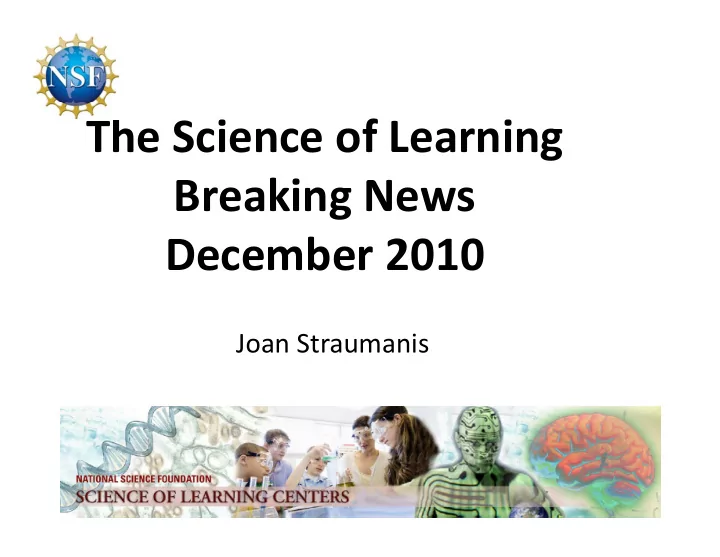

The Science of Learning Breaking News D December 2010 b 2010 Joan Straumanis
Current SLC Portfolio 2004 Cohort 2006 Cohort CELEST: Center for Cognitive SILC: Spatial Intelligence and and Educational Neuroscience d Ed ti l N i L Learning Center (Temple U) i C t (T l U) (Boston U) http://spatiallearning.org http://celest.bu.edu TDLC: Temporal Dynamics of TDLC: Temporal Dynamics of LIFE: Learning in Informal and Learning Center Formal Environments (U of (UC ‐ San Diego) Washington) http://www.life ‐ http://tdlc.ucsd.edu slc.org slc.org VL2: Visual Language and PSLC: Pittsburgh Science of Learning Center Learning Center (Carnegie ‐ (Gallaudet U) ( ) Mellon U) Mellon U) http://vl2.gallaudet.edu http://www.learnlab.org
Definition of Robust Learning: • Retained for a long time • Effective preparation for further learning or practice practice • Transfers to novel situations f l
To Increase Learning: Enlist brain’s motivational & reward systems; compete effectively with other rewards Manage sleep to consolidate memory Multimodal input Ensure engagement (“Active Learning”) Ensure engagement ( Active Learning ) Manage timing of practice, reinforcement (Assistance Dilemma) Provide plenty of social interaction!
What we’ve learned about STEM learning STEM learning… (a synthesis) Expert explanation……….is not as effective as Peer explanation …which is not as effective as Self explanation Self explanation…..which is not as effective as which is not as effective as Teaching another… even when that other is a Teaching another… even when that other is a computer ‐ generated avatar
Findings about Social Interaction: • Babies need it to learn language • Teaching another is powerful so • Teaching another is powerful…so • Team/group learning is effective • “Mere belief in the social” works! • But so does teaching a computer avatar!!
Social Dynamics of Learning: of Learning: Human, Robot, Vid Video
UW MEG Brain Imaging Center LIFE reported the first in the world MEG recordings of awake infants engaged in a cognitive task (Imada Kuhl cognitive task (Imada, Kuhl et al., 2006). Magnetic fields generated by neuronal activity in the brain are recorded outside the brain by magnetometers. International collaboration with Helsinki University of Technology and Elekta Oy – Ribbon-Cutting on May 24, 2010 all 6 SLCs in Helsinki in Dec., 2009 8
Science at CELEST • Focus : Brain mechanisms of learning during planning, exploring, communicating & remembering • Approach : Integration of modeling & experimentation • Cross ‐ Cutting Research Themes : processing bottlenecks , dynamic coding functional connections neural plasticity dynamic coding, functional connections, neural plasticity, neuromorphic engineering • Examples: Links between gamma oscillations, plasticity & learning to study phase coding in working memory, illuminating cognitive bottlenecks; biologically inspired microprocessing using memristors using memristors
Center of Excellence for Learning in A National Science Foundation Science of Learning Center Education, Science, and Technology The DARPA SyNAPSE Project The DARPA SyNAPSE Project Systems of Neuromorphic Adaptive Plastic Scalable Electronics Hardware goals 10 6 “neurons”/cm 2 10 20 “synapses”/cm 2 ~100 milliwatts/cm 2 10,000 chips, 1000 watts To date: Wrong hardware! stuffed in a shoebox Brain-like computations with Brain like computations with CELEST i CELEST is working with ki i h co-located DATA STORAGE, Industrial partners HRL Labs and SIGNAL TRANSMISSION, and Hewlett-Packard to devise LEARNING are inefficient in next generation computing hardware. next-generation computing hardware. di it l digital computers t 10 10 neurons Such machines MUST LEARN , because 10 14 synapses they will not be fully “programmable”. Brain Blue Gene 20 W 1 GW, thousands 1.3Kg of racks
Phase ‐ Coding of Objects in Working Memory What are the fundamental constraints on working memory capacity? This analysis was directly inspired by CELEST interactions between members of the Hasselmo and Miller labs. Koene, R. & Hasselmo, M. (2007). Cerebral Cortex, 17, 1766–1781. Spikes associated with the first and second Spikes associated with the first and second items occur at different phases within local field potentials that cycle at approximately 32 Hz in the prefrontal cortex of monkeys i h f l f k performing a working memory task. 11 Siegel, Warden, and Miller (2009) Proc. Nat. Acad. Sci.
TDLC:Time matters for processing… “ say ” y Frequency F “ stay ” 100 ms Ti Time (milliseconds) ( illi d ) These wave forms are id entica l id entica l except for the artificially inserted gap and a compensating shrinkage of the waveform.
Facial Expression during problem solving. Littlewort, Phan Reilly and Bartlett (3 2) Phan, Reilly, and Bartlett, (3.2)
Facial Expression during problem solving. Littlewort, Phan, Reilly, and Bartlett, (3.2) Initiative 6- Translational Research Initiative 6- Translational Research
Recommend
More recommend